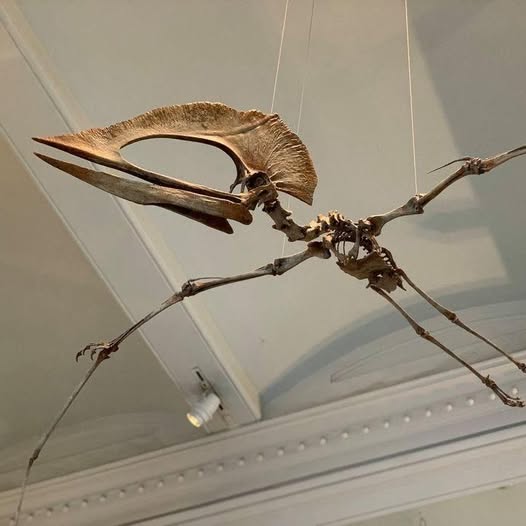The Cretaceous skies, 110 million years ago, were home to the magnificent Tupuxuara leonardii, a pterosaur boasting a 15-foot wingspan and a striking, fan-shaped crest. This elaborate headpiece has captivated paleontologists, sparking debate about its purpose and the potential visual splendor of these ancient aviators.
The Enigmatic Crest: A Multifaceted Feature
Scientists have proposed several theories to explain the function of Tupuxuara’s distinctive crest.
- Aerodynamic Advantage:
- Some suggest that the crest served as a sophisticated aerodynamic tool, enhancing the pterosaur’s flight capabilities.
- It may have acted as a rudder or stabilizer, allowing for more precise maneuvering and efficient gliding through the prehistoric skies.
- Species Recognition:
- The crest could have played a crucial role in species identification, enabling Tupuxuara to distinguish between members of its own species and other pterosaurs.
- This would have been particularly important in a diverse ecosystem with numerous flying reptiles.
- Mate Attraction:
- Analogous to the vibrant plumage of modern birds, the crest may have served as a visual display for attracting mates.
- A larger, more elaborate crest could have signaled strength, genetic fitness, and overall desirability, enhancing the pterosaur’s reproductive success.
The Potential for Color: A Prehistoric Spectacle
The possibility of brightly colored crests adds another layer of intrigue to the Tupuxuara mystery.
- Visual Communication:
- If the crests were indeed colorful, they would have served as powerful visual signals, enhancing their effectiveness in mate attraction and species recognition.
- This would have transformed Tupuxuara into a visually stunning creature, capable of dazzling displays in the ancient skies.
- Coloration Hypotheses:
- Researchers hypothesize that the crests may have exhibited vibrant hues, similar to the colorful displays of modern birds.
- These colors could have ranged from bold reds and oranges to iridescent blues and greens, creating a captivating spectacle.
- Reconstructing the Past:
- While direct evidence of coloration is challenging to obtain from fossils, comparative studies with modern animals and advanced imaging techniques are helping to shed light on this possibility.
- Understanding the coloration of ancient animals helps us to better understand the environment they lived in.
Unraveling the Mysteries of the Cretaceous Skies
The debate surrounding Tupuxuara’s crest highlights the ongoing quest to understand the lives of these fascinating prehistoric creatures.
- Paleontological Insights:
- Fossil discoveries and ongoing research continue to provide valuable insights into the anatomy, behavior, and ecology of pterosaurs.
- Each new finding contributes to a more complete picture of these ancient aviators.
- The Power of Speculation:
- While scientific evidence is crucial, speculation and creative thinking play a vital role in generating new hypotheses and driving research.
- Imagining the possibilities of colorful displays and complex behaviors helps to bring these ancient creatures to life.
- The Ever-Evolving Narrative:
- Our understanding of prehistoric life is constantly evolving, as new discoveries and technologies challenge existing theories.
- The mystery of Tupuxuara’s crest serves as a reminder of the vastness of the unknown and the excitement of scientific exploration.
The Tupuxuara leonardii’s crest remains a captivating enigma, prompting us to imagine the vibrant and dynamic world of the Cretaceous skies. Whether used for flight, flirtation, or both, this remarkable feature underscores the beauty and complexity of prehistoric life.

CÁC TIN KHÁC
Mary Walton: The Forgotten Inventor Who Helped Clean Up America’s Cities
Tomb of Queen Nefertari in the Valley of the Queens, Egypt
Discover the Hypostyle Hall of the Temple of Hathor at Dendera
Venus de Losange: Unveiling the Mystery of a 20,000-Year-Old Paleolithic Icon